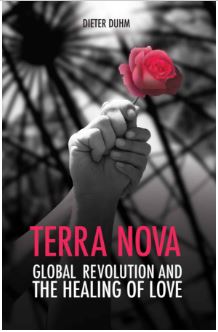 Terra Nova. Global Revolution and the Healing of Love by Dieter Duhm
Terra Nova. Global Revolution and the Healing of Love by Dieter Duhm
Review by David Lorimer
The central theme of this visionary yet practical book is how we generate a new form of humaneness based on trust and mutual support. In the late 1960s, the author was a Marxist activist, but he realised that Marxism did not address the inner aspect of life from which outer patterns of behaviour emerge. This led him to found a community in 1978, which moved to become Tamera in Portugal in 1995. In the introduction, he states that the human being is the cause of his own failure because he disregarded some essential aspects of his own inner world – the driving powers of the soul, libidinous longings, sexuality and animality, spiritual powers, hopes and fears. His thesis is that a transformation of the inner world will lead to a corresponding outer transformation – a critical aspect of our story but then our outer structures also shape our inner world and draw out certain features of human nature. As this year has shown only too clearly, we live within a matrix of fear and violence portrayed by the media, even if most of us are in fact living peacefully in our own communities. I’m sure he is right in regarding the community or group as a microcosm of human existence, containing as it does light and dark elements. It is important to remind ourselves, as Aldous Huxley pointed out in 1942, that a humane goal cannot be reached through inhumane means. Whatever the short-term imperatives, violence will create further violence in a spiral of destruction.
We need to reflect deeply on what it means to choose life and trust and to realise our inherent interconnectedness as expressions of one life and one consciousness. We are deeply embedded in a morphic field of fear (Duhm uses the word morphogenetic, but Rupert Sheldrake himself would use ‘morphic’ in this wider context) – primarily fear of loss and separation at a deep unconscious level, where so many horrific images of war and suffering are stored. An important part of his thesis and the work of Tamera is that our patriarchal society and institutions have for centuries suppressed women’s sexuality (Riane Eisler has written extensively about this) in systems of domination and possession. This requires a freeing up of love and sexuality based on real contact and trust rather than exploitation. Duhm makes a deep connection between lying, betrayal, fear and violence in love with their corresponding expression in war – all this destroys trust and therefore openness to love and compassion. This applies especially to bringing up children, who need this atmosphere of love in order to flourish.
The second section on concrete utopia explains how we can create a new morphic field from the inside out. He gives some remarkable examples from Satprem to illustrate that our thoughts and feelings shape how the outer world reacts to us. He calls this acting through the ‘inner operator’ or higher self corresponding to the sacred matrix or cosmic pattern of life also represented in our culture by the power of Christ. A further manifestation is Ananda or joy, which enables a harmonious relationship in Tamera between humans and nature, even those we normally regard as pests. The overall vision is of a new humanity on a healed Earth and it is critical to articulate and hold this vision – as embodied in communities like Tamera – as a field to attract its own realisation. It can only start small and grow, like all seeds in nature.
The third part spells out in more detail how the Earth and humanity can be healed, as has happened for instance at Tamera due to their water retention scheme that has regenerated the previously arid area. Life is inherently healing and the entelechy of each organism contains its own blueprint for development. Duhm describes the processes for the development of trust and solidarity used at Tamera for the healing of love and the freeing of sexual expression as well as the recognition that our human challenges are universal. He summarises these in a series of guidelines and more general ethical principles all based on the primacy of love – especially the deep soul connection – for human flourishing. Nonviolent human culture has to be based on truth, mutual support, responsible participation in the community, transparency, reliability and care for the animal world. At an emotional level this means becoming free of reactivity so that the spiritual powers of the universe can act through you.
The fourth part explains the global healing biotopes or cells, of which the Tamera community is one. These are anchored in the universal powers of life and creation, taking ‘a determined, non-negotiable stand for life.’ Members shift from an individual to a community identity and become more radically themselves as they drop the need to be normal in society’s terms. This goes way beyond the collectivism associated with Marxism and its emphasis on social conditioning. As people reveal themselves and are really seen, they are loved for who they are. They also magnetise around a higher spiritual ideal. In our time we not only need a strong vision of hope and love but a practical demonstration of its reality. This visionary book and the Tamera community are beacons of our new possibilities and give us a compass direction to the creation of a more trusting world to which our young people can aspire.
